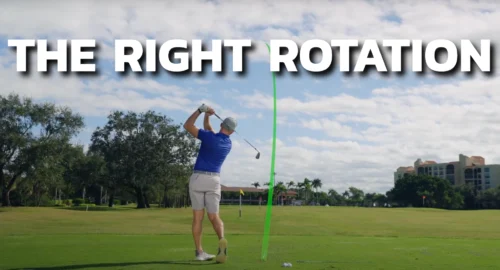
When inconsistent contact plagues your swing, you’ll notice it right away with higher scores and struggling to hit your target. Understanding just a few key aspects of your swing movement and incline can lead to significant improvements.
Move With an Incline, Not a Level Turn
One of the most common misconceptions about the golf swing is that it should be executed with level shoulders. Instead, golfers should aim for an inclined motion, as shown in the video tutorial above.
Since the ball is on the ground, it’s crucial to allow your lead shoulder to move down as your trail shoulder moves up during the swing. This creates a more dynamic and effective motion, resulting in better contact with the ball, and a higher, stronger ball trajectory once it’s hit.

Use the Piston Motion Drill
To reinforce the idea of incline in your swing, where the trail shoulder moves not only back but up, a good way to practice is using a small drill that mimics both a pulley system and the incline you want to see in the golf swing.
You can use a string attached to an alignment rod to visualize this concept, with an end of string in either hand. As you pull, focus on engaging your body rather than just your arms. This exercise helps emphasize the importance of pivoting your body correctly, enhancing the control you have over your swing in this motion. You can see this in action below.

Maintain Consistent Body Angles
Another key to a solid swing is maintaining your body’s angle throughout the motion. Instead of letting your body rise or fall excessively, aim to keep your posture steady as you swing (above).
Visualizing a circle around your head can help you stay within that frame, ensuring that your swing remains smooth and consistent without jerky movements.
You also want to be sure to balance both shoulder movements; while your lead shoulder should be moving down, don’t overlook the importance of your trail shoulder moving up. Maintaining this smooth motion is the most important aspect of a fluid swing.
By focusing on these fundamental tips—utilizing an inclined motion, practicing with the piston drill, balancing shoulder movements, and maintaining consistent body angles—you can significantly improve your golf swing.
For more tips on improving all aspects of the golf swing, from ball striking to distance, be sure to check out our library of training videos.

